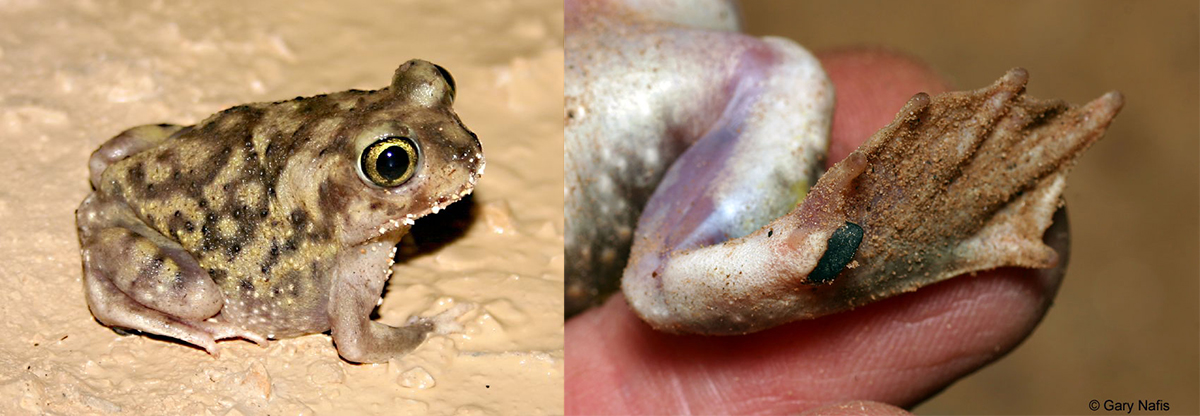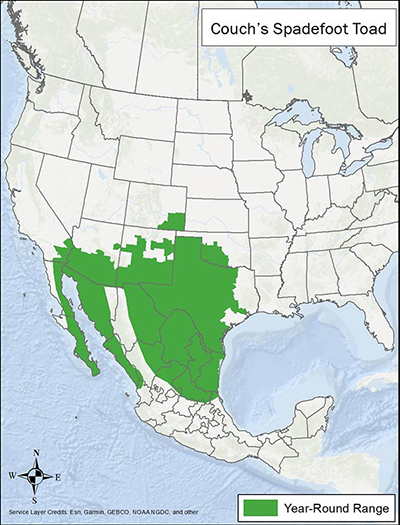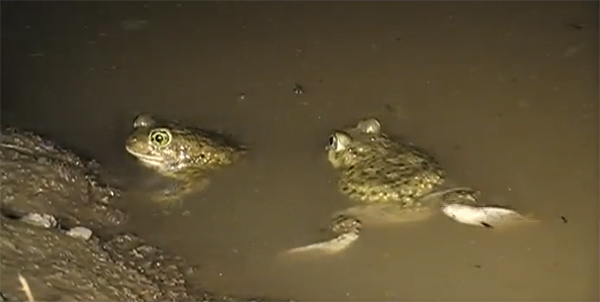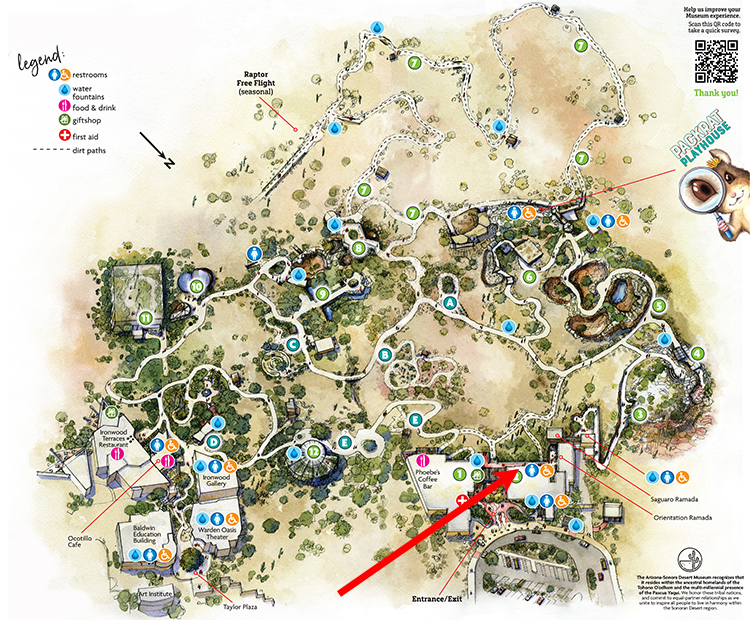Couch's Spadefoot

Left: Side view of a Couch's Spadefoot. Clinton & Charles Robertson from Texas, USA, CC BY-SA 2.0, via Wikimedia Commons. Right: The underside of a spadefoot’s hind foot, showing the hard growth that helps them dig.
About
Hip, hop, hooray! The spadefoots are coming out today! When the monsoon rains come, Couch’s spadefoots emerge from their burrows to party in the puddles. Spadefoots have soft, bumpy skin that is green, yellow, or olive with blotches or spots of black, brown, or dark green. Their belly is white and has no markings.
Spadefoots are often referred to as toads because they look a lot like one, but spadefoots are not actually toads. And they aren’t frogs either. In fact, spadefoots are their own special category of amphibian!
Adaptations
Life isn’t easy for amphibians in the dry desert — they need to be moist at all times so they can absorb oxygen through their thin skin. Luckily, Couch’s spadefoots have amazing adaptations for surviving in the Sonoran Desert. On the bottom of their back feet they have a “spade” — a hard growth that helps them dig down into the dirt. When water starts to dry up, spadefoots will use this tool to bury themselves underground until the next rain. While underground, spadefoots will lay dormant or estivate. A spadefoot may stay buried for up to two years before it comes back out of the ground! Couch’s spadefoots are able to sense when a storm is coming by the vibrations from rainfall and thunder.
Food Web
Spadefoots eat mostly arthropods such as beetles, grasshoppers, ants, spiders, katydids, and termites. Because they spend so much time underground, while out, a spadefoot can eat enough food in one meal to last the entire year! Coyotes, snakes, and large birds like crows, owls, and herons will eat spadefoots.

Habitat and Range
Couch’s spadefoots do well in extremely dry conditions. They are typically found in areas with sandy soils with creosote bush and mesquite trees, but can also be found in short grass prairies, grasslands, farmlands, and along roads during summer thunderstorms. Couch’s spadefoots are found in southeastern California, southern Arizona, southern New Mexico, southeastern Colorado, Texas and down into Mexico.
Range map provided by International Union for Conservation of Nature

Family Life
Monsoon season (approx. June-Sept.) is a race against the clock for spadefoots! They only have until the puddles dry up to eat enough food for the rest of the year, find a mate to breed with, and for the eggs to fully transition into adults. Most spadefoots in an area will breed during the first rains of the season allowing their offspring the rest of the season to turn into adults and eat their fill.
Male spadefoots emerge first from the ground, find a pool of water called their breeding pool, and start calling to attract the females. This is a very noisy process—listen here! Once the spadefoots have paired up, one female can lay as many as 3000 eggs. Only a small number of these eggs will make it to adulthood, so laying a large amount increases the chances that some of their offspring will survive.
Couch’s spadefoot’s metamorphosis is an impressively speedy process. Eggs will begin to hatch as soon as 15 hours after being laid, and the full transition from tadpole to adulthood can be completed in as little as 9-14 days! For comparison, most toad and frog species take 40-90 days to complete the same transition.
Glossary
- Spade:
- A tool with a sharp-edged, typically rectangular, metal blade and a long handle, used for digging. Also, the hard growth on a spadefoot’s hind foot helps them dig down into the dirt.
- Estivate:
- A state of dormancy similar to hibernation, but to avoid hot and dry conditions. Estivation is primarily seen in reptiles, insects, fish, and amphibians.
- Arthropod:
- An animal with a segmented body, jointed legs, and an exoskeleton.
- Metamorphosis:
- The process of transformation from a young form to an adult form (example: caterpillar to butterfly).
Fun Facts
- Couch’s spadefoots have a toxin on their skin that they ooze out to keep predators from eating them. This substance has also been known to cause allergy-like symptoms in humans and pets. Some people think that this secretion makes spadefoots smell like peanut butter!
- Spadefoot calls sound similar to a sheep or goat.
- Coach’s spadefoots fluoresce under UV light.
Challenges
Spadefoots face habitat loss and challenges related to climate change, specifically drought and changes in rainfall. Since so much of their life cycle depends on monsoon season, any changes in the frequency or timing of these summer rains could have negative impacts on this animal.
Conservation
Least concern.
At The Museum

Spadefoot Splash — new exhibit opening in 2026!
See spadefoots in the Reptile and Invertebrate room.
Open year-round.
Accessibility: Rough terrain & wheelchair accessible
